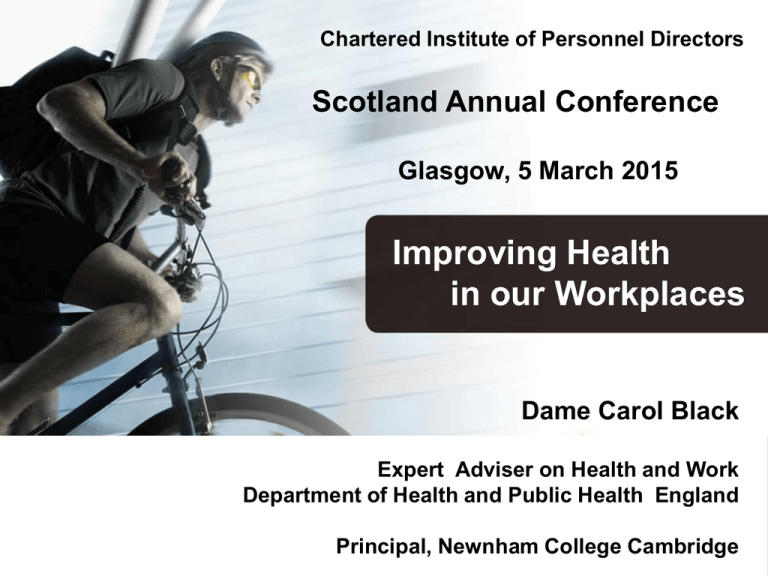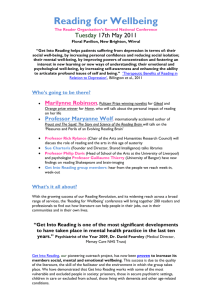Part 1
advertisement

Chartered Institute of Personnel Directors Scotland Annual Conference Glasgow, 5 March 2015 Improving Health in our Workplaces Dame Carol Black Expert Adviser on Health and Work Department of Health and Public Health England Principal, Newnham College Cambridge CBI : GETTING BETTER 2014 Workplace Health as a Business Issue “ The working world is getting ever more complex, with flexibility and globalisation beginning to break down the barriers of what we are used to. In the UK, we need to compete on the quality of what we do – and that makes staff performance and productivity vital. And workplace health is essential to both of those key factors. ” Sponsor: Medicash Neil Carberry CBI director of employment & skills What prevents us from working – or from working well and feeling good ? • Common mental health problems • Musculo-skeletal problems • The quality of work and the workplace - organisation of work - managerial behaviour and leadership - absence of ‘good work’ • Other important reasons - long-term conditions – mental and physical - psychosocial/ home-related problems - lack of education and/or skills. Common Mental Health Problems : What and Why • Stress, anxiety, mild depression - high prevalence across populations - little or no objective disease or impairment - most episodes settle rapidly, though symptoms often persist or recur - essentially whole people, should be manageable. • These symptoms are often an expression of, or reaction to, poor work, poor workplaces, and/or poor leaders or managers. • Health interventions such as drugs, EAPs, CBT etc may help BUT not address the real root problem(s). Mental Health and Work Globally, a growing realisation that : • Mental ill-health among working-age people is a priority challenge for the labour market and social policies … OECD 2011 • .... an issue neglected too long – with widespread fears and stigma. • Employment opportunities for people with mental ill-health are low, many of those who are employed struggle in their jobs, and disability caused by mental ill-health is frequent and rising. • The costs of mental ill-health, for individuals, employers and society, are very large. (The ILO estimates the cost conservatively at 3 to 4% of Gross Domestic Product in the EU). Governments recognise - this situation is not sustainable. Measures of productivity loss and mental ill health Percentage of workers with various productivity losses in past 4 weeks due to a mental health problem : Source: OECD calculations based on Eurobarometer Survey of 21 countries 2005 Well-being and Engagement • Approximately 25% of the variation in reported levels of employee productivity is predicted by a combination of: - psychological well-being - perceived commitment of the organisation to the employee - access to appropriate resources, and - good communication. Donald et al, 2005 • Robertson and Cooper have shown that the top driver for employee engagement is the extent to which employees believe that their senior management has a sincere interest in their well-being. • High levels of staff engagement are not sustainable unless well-being is maintained, through good work and good workplaces. • Engagement without well-being can lead to a burned-out workforce. The Bottom Line • Mental illness costs employers about £ 28 billion per year: - prevention and early identification of problems should save employers at least 30%, or £ 8 bn a year. • November 2009 NICE guidance presents the business case. NICE Costing tool available at www.nice.org.uk/PH22 - calculates the overall cost of mental health in the workplace (all aspects) and potential savings - calculates that for a company with 1,000 employees, mental ill health costs about £835,000 per year - reduction by 30%, through taking simple steps, would save £250,000 per annum Key players : workers’ health and productivity Health professionals (Primary and secondary care) Public Health (professionals, local councils) Employers Non-governmental bodies and charities Employees (Patients) OH professionals Trade Unions Governments to make policy, initiate, support, encourage, and where necessary legislate. The crucial interfaces The interfaces, between patient/employee, health professionals and employer, need to satisfy all parties. Essential ingredients: • well-informed, work-knowledgeable health professionals • employers that create good work and good workplaces • employees well, and engaged. Essential Enablers of Health, Wellbeing and Resilience • Early appropriate intervention by health professionals • Good work and workplaces • Proactive ‘reformed’ OH • Staff engagement • Empowering leadership • Supportive managers • Promotion of health and wellbeing • Integration of Health, Safety, OH and Wellbeing programmes • Attention to positive mental health and resilience All the above also improve safety and patient care. Early action by health professionals • Understanding by all health professionals of the social determinants of health • Proper use of the electronic Fit Note, with more use of “.. may be fit to work if ..” (current usage about 15% of written Notes) • Return to work regarded as a desirable clinical outcome, and measured as such by the clinical regulator • Full use of the new Fit for Work Service, available in Scotland through the NHS. UK Government Response 2013 to Sickness Absence Review 2011 • Accepted a recommendation to introduce a state-funded health and work assessment and advisory service [now Fit for Work: in Scotland NHS delivered, as Fit for Work Scotland] • The Service has been designed to intervene in sickness absence at the four-week point. • On 1 January 2015 a recommended tax exemption came in on medical treatment recommended by Fit for Work or employer-arranged OH services. Department for Work & Pensions Fitness for work: the Government response to ‘Health at work – an independent review of sickness absence’ Presented to Parliament by the Secretary of State for Work and Pensions by Command of Her Majesty January 2013 Fit for Work Scotland … is being introduced to support a reduction in the length of sickness absence from work and reduce the impact that absence has on individuals, employers and the State. The service aims to: • support people to reduce the length of sickness absence • reduce the chances of people falling out-of-work and on to benefits • increase awarenesss of the benefits of working to a person’s health • increase the positive actions taken by employers, employees and GPs in contributing to a change in attitudes towards health and work. Fit for Work Scotland : Why? Currently in Scotland, each year : • 130 million days are lost to sickness absence, costing economy £15 bn • employers face bill of about £9 bn for lost production and sick pay • individuals absent sick lose around £4 bn in earnings. It is estimated that Fit for Scotland will : • reduce employers’ sick pay costs by a third • reduce cost of out-of-work benefits by a third, to £6 m per year • increase Scottish tax and NI revenues by £10 m to £21 m per year Early intervention: Scotland EASY sickness absence service Cost effectiveness study after four years (2008 to 2012), NHS Lanarkshire compared with NHS in rest of Scotland • Is the service effective in reducing sickness absence? • Does the service offer net economic benefits? J.Brown et al, Scand J work Environ Health, on-line. Easy Access to Support for You (EASY) • Biopsychosocial approach to case management • Line Manager immediately informs EASY call centre of the absence • Centre aims to call employee on first day of absence (FDA) • Reference to OH services on tenth day of absence NHS sickness absence rates, 2007-12 Lanarkshire vs Rest of Scotland Lanarks EASY service, telephone early in absence, provided in Lanarkshire only (EASY = Early Access to Support for You) Rest Scotland J.Brown et al, Scand J work Environ Health, on-line. In 2009 Lanarkshire rates came below those in rest of Scotland, for first time. EASY evaluation - outcome • Although sickness absence in NHS Lanarks was falling beforehand, following EASY’s introduction absence reduced by 21%. • Nonspecific tightening of sickness absence policies in rest of Scotland NHS reduced sickness absence by about 9% in same period. • There were commensurate economic benefits, cumulative from 2007 to 2012, greatest at the outset and diminishing over time. • MSK and Mental Health problems accounted for 23 and 19% of days lost. • Absences due to MSK problems reduced from 32 days on average in year one to 20 days in year four – no significant change for other diseases • By 2012 NHS Lanarks absence rates were close to those in rest of NHS Scotland – so is EASY still producing economic benefit? Good Workplaces Key features common to those organisations which have achieved success in promoting physical and mental health and well-being: • Senior visible leadership • Accountable appropriately-trained managers throughout the organisation • Integration of traditional Health and Safety with promotion of Health and Wellbeing • Monitoring and measurement to ensure continuous improvement • Empowering and facilitating employees to care for their own health • Enabling staff engagement Board Leadership : National Health Service England • Board level involvement will make the difference • Where NHS Boards live the values they want to achieve, staff will take those values seriously. • A named board member responsible for H&WB and reviewing progress every 6 months will drive this agenda forward. Example: York Teaching Hospitals NHS FT • Used board engagement to drive progress across the Trust • Board visibly involved in events to promote better health and wellbeing, and communicated this to staff. • Delivered sickness absence savings of £2.7m yearly, and 72% reduction in long-term absence. Leaders and back pain : predictors not always ‘medical’ After adjustment for age, sex, skill level, back pain severity and other potential confounders, the most consistent predictors of back pain were: • decision control at work (lowest OR 0.68; 99% confidence interval (CI): 0.49 -0.95), • empowering leadership at work (lowest OR 0.59; 99% CI: 0.38-0.91) • fair leadership at work (lowest OR 0.54; 99% CI: 0.34-0.87) Christensen JO, Knardahl S. 2012 Do not forget leadership and other psycho-social factors Effect of Managers on Employee Well-being • A longitudinal interventional study (n = 188) in a large Danish local government organisation, where poor social support, lack of role clarity and lack of meaningful work were significant problems. • Intervention (measured at entry and 18 months later) : - improved team working with a degree of self-management - Question: Did active middle management support for the intervention mediate its impact on well-being etc. ? • Results : - structural equation modelling showed that active middle-manager involvement, as perceived by employees, correlated with job satisfaction and well-being. K. Neilsen. National Research Centre for the Working Environment, Denmark Train your Managers • Good line management is key to employee Wellbeing. • Managers should focus on: – effective communication with the employee and other members of staff – awareness of the issues and the ability to empathise – developing open culture with employees feeling able to discuss their problems. • Learning about mental health enables managers to judge when they need to refer employees to outside help. • There are many sources of advice and good training courses. Re-integration into Work : after Mental Ill-health OECD Report 2011 : • Globally, employment opportunities for people with mental ill-health are low, many of those who are employed struggle in their jobs, and disability caused by mental ill-health is frequent and rising. Time to Change, survey of the public, October 2014 • 7% rise in willingness “to work with someone with a mental health problem” (69 to 76%) Managers are crucial to successful re-integration. Integration : Total Worker Health • Traditionally, workplace Health and Safety has been separated from Health Promotion. • NIOSH (National Institute for Occupational Safety and Health, USA) is now emphasising Total Worker Health : “ Growing evidence supports the effectiveness of combining these efforts through workplace interventions that integrate health protection and health promotion. ” “ Integrating health protection and promotion will create synergy, enhance overall health and wellbeing of the workforce, and decrease the likelihood of workplace injury and illnesses.” “ Having a psychologically-healthy workplace and having a profitable and sustainable business are linked.” Integration : Total Worker Health Gains in health wellbeing, fitness for duty Organisational Health and Safety Strategic, integrated Cost minimisation Absence of illness or injury incidents Harm Minimisation Compliance, systems, culture Illness/injury incidents Gains in company performance Expanded value chain goes beyond absence of injury Loss Control Slide courtesy of Anne-Marie Feyer and Niki Ellis Health and Wellbeing Programmes Depend on circumstances – place, time, organisation • Consult staff – then design. • Mental Health : Prevention 1st, 2nd and 3rd ! - counselling, mediation, yoga, stress management, resilience training, mindfulness • Physical Health : (also benefits mental resilience) - health assessments, running clubs, discount on gym membership, fit bug, smoking cessation, dietary changes in canteens, Well Point, physiotherapy, pilates, reflexology, etc. • Lifestyle : - make the most of money, well done letters, flexible retirement policies, lifewise flexible working, reading clubs, choirs, garden allotments . The gradient in health and motivation in workplaces • Overall organisational productivity depends critically on workers’ aggregate performance - their contribution is essential to success. • In particular, there is a need to understand the degree of linkage, in typical pyramid-shaped organisations, between, on average, poorer health (mental and physical) and lower motivation and engagement at work. • Recognition of this needs to be properly factored in to management thinking about health to enhance productivity Top management Usually declining income and health Workforce, many more at the foot, is not uniform in health, wellbeing or motivation Heart Age and Health Inequalities A simple online tool to find out your estimated Heart Age based on input of personal information on risk factors. Factory Site : Marketing Site : Inequalities of health ! 0 Heart Age above actual 0 Proportion of people in sample with heart ages in different ranges above their actual age – very different distributions at the two sites. + Do Workplace Wellness Programs Work? Johns Hopkins study, JOEM, September 2014 - considering programmes in the US system. Best and promising practice: • Health education • Supportive social and physical environments • Integration with HR, infrastructure and environmental health and safety • Links between HP and related programmes e.g. EAP Journal of Occupational and Works if: Environmental Medicine • Goals aligned to business • Programme design is evidence-based • Evidence-based implementation Modified from • Ongoing evaluation Niki Ellis If only goal is to save money, maybe not worth it The King’s Fund 2015 : NHS Staff Engagement • NHS providers with high levels of staff engagement tend to have lower levels of patient mortality, make better use of resources, and deliver stronger financial performance. (West and Dawson 2012) • Engaged staff are more likely to have the emotional resources to show empathy and compassion, despite the pressures they work under. • So Trusts with more engaged staff tend to have higher patient satisfaction, with more patients reporting that they were treated well. (Review of Staff Engagement and Empowerment in NHS, 2014) Six building blocks for a highly engaged workforce • Shared direction • Distributed leadership • Supportive styles • Transforming tools • Trustful culture • On Board agenda The King’s Fund 2015




